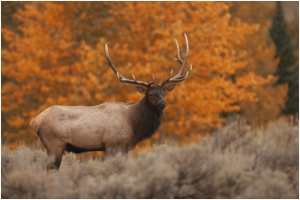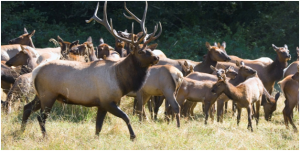North American Elk, Wapiti
[separator headline=”h2″ title=”Did you know…”]

Valerie Assinewe, Professional Writing Program Intern
The North American elk or wapiti (Cervus elaphus canadensis), observed by European explorers in the 1500’s were likely named after the European elk (Alces alces)—commonly called moose in North America—due to a resemblance in size.
The wapiti is one of the largest species of the cervidae or deer family in the world, and one of the largest land mammals in North America. The moose is the largest. The average height of an elk at its shoulders is about 1.2-1.5 m while their weight can range from 147-500 kg.
Wapiti were once found throughout much of North America. In the late 1800s, the animals were decimated due to a combination of overhunting and habitat loss due to urbanization and farming. Of the six subspecies only four remain: the Roosevelt, Tule, Manitoban and the Rocky Mountain. The Eastern and Merriam subspecies have been extinct for at least a century.

Between 1998 and 2001 the Ontario Ministry of Natural Resources (MNR), in collaboration with many partners and volunteers, released 443 wapiti from Elk Island National Park, Alberta at four locations (Bancroft, Blind River, Sudbury and Kenora) across the province as part of an elk restoration program. Since 1998, monitoring has revealed that restored elk herds have grown, dispersed and in some areas struggled with Ontario’s diverse landscape patterns and uses. The first modern elk hunt in Ontario was initiated in the Bancroft area in the fall of 2011.
Only the males have antlers. They start growing the antlers in the spring and are shed after the breeding season in winter with the drop of testosterone level. The largest antlers may be 1.2 m long and weigh 18 kg.
Both stags/males and hinds/females reach sexual maturity at sixteen months, although young bulls do not usually mate until they are a few years old and can compete with the mature bulls. During the mating period known as the rut (August to early winter), mature bulls compete for the attentions of the cows and will try to defend females in their harem. Rival bulls challenge opponents by bellowing and by paralleling each other, walking back and forth. This allows the combatants to assess the other’s antlers, body size and fighting prowess. If neither bull backs down, they engage in antler wrestling sometimes sustaining serious injuries.

Wapiti Bull with Harem
[separator headline=”h3″ title=”Why do they make that sound?”]Bulls have a loud vocalization consisting of screams known as bugling, which can be heard for miles. Bugling is often associated with an adaptation to open environments such as parklands, meadows, and savannas, where sound can travel great distances. Females are attracted to the males that bugle more often and have the loudest call. Bugling is most common early and late in the day and is one of the most distinctive sounds in nature.
Wapiti have an average lifespan of 8-12 years in the wild and up to 20 years in captivity.

